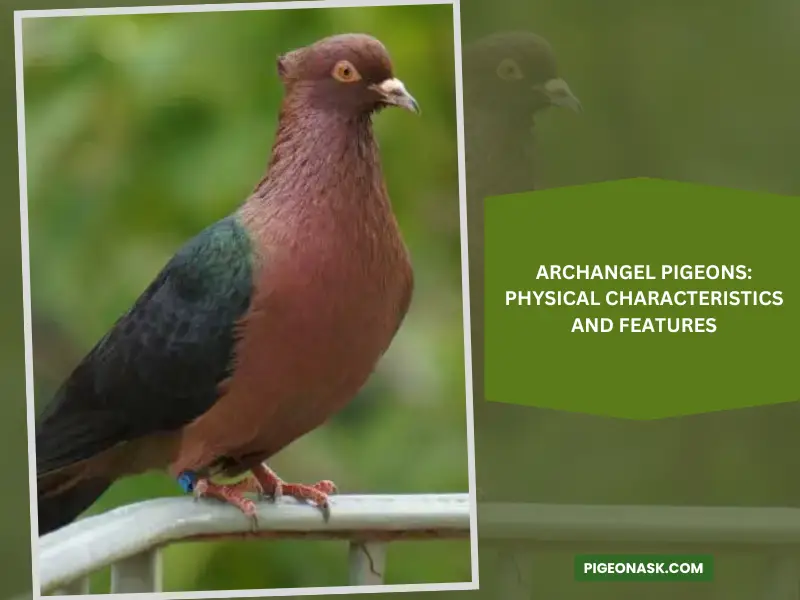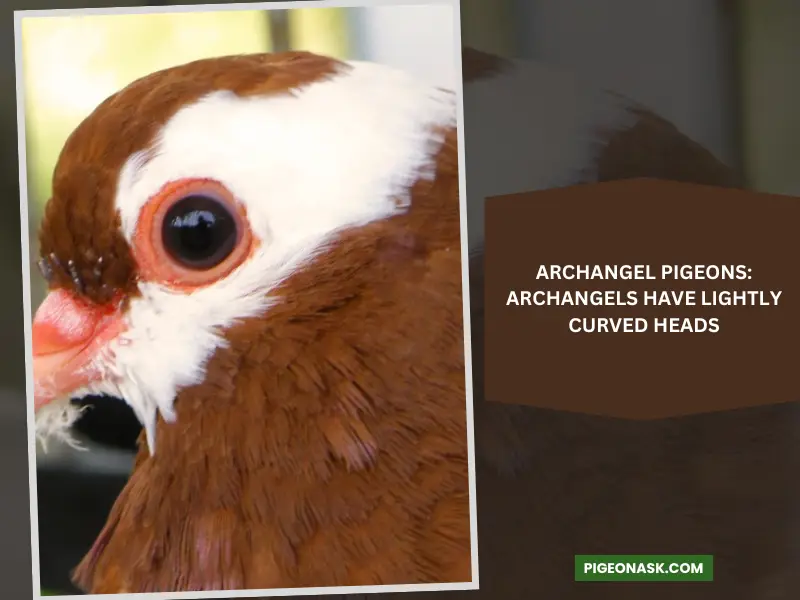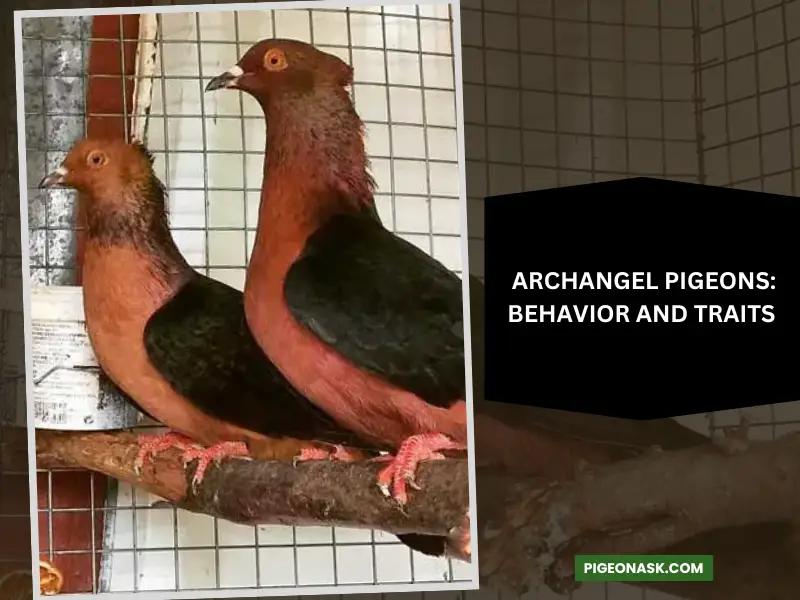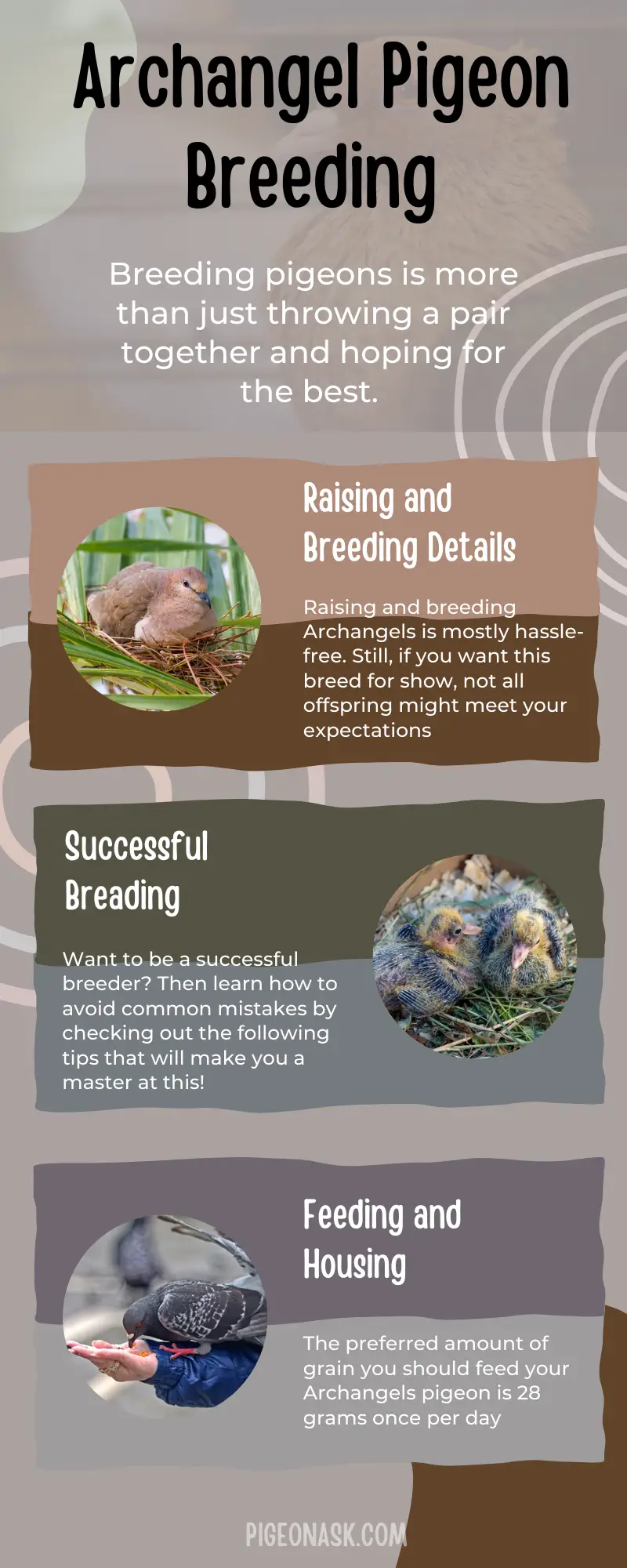Archangel Pigeon: Breed Guide (With Infographic)
Did you know that the Archangel pigeon can be a loyal pet? That’s right. Breed and raise them correctly, and they will follow you around as your newest and closest friend.
And that’s not even the most captivating trait about this pigeon type!
Archangel pigeons have gorgeous wings featuring a metallic sheen and one of many colors, including black, white, or blue. Similarly, the orange-colored eyes are other features that make this species so captivating.
Want to know the best part? Breeding this type of pigeon is relatively easy, especially for first timers!
So, you better stick around to learn all about Archangels, how to breed them, things to consider, and more!
Archangel Pigeon Profile
| Name | Archangel Pigeon |
|---|---|
| Scientific Name: | Columbia Livia |
| Common Names: | Copper Blackwing Gimpel Copper WhiteWing Peak Crested Copper Blackwing Gimpel Gimpeltaube |
| Origin: | Dalmatia / Illyria |
| Size: | 13 (33cm) and 13.4 inches (34cm) |
| Weight: | Between 280 and 400 grams |
| Lifespan: | From 7 to 10 years |
| Physical Features: | Fancy pigeon breed, curved heads with or without crests, vivid eyes, long beaks, long necks, wide breasts, sloped back, long wings, lengthy and narrow tails. |
| Temperament: | Quiet and gentle |
| Behavior: | Non-aggressive, loyal to owner & friendly with other pets |
| Special Features: | Metallic sheen feathers Dark, orange iris Bronze or golden body White, black, or blue wings |
| Breeding and Maintenance: | Straightforward breeding Considerable maintenance |
Overview
Archangel pigeons are domesticated birds popular for the metallic sheen of their feathers. This breed descends from the rock pigeon, also called Columbia Livia.
Typically, this pigeon served as messaging or racing pigeons, but now breeders raise them for show performances or as pets.
Looking for more articles about pigeons breed:
History and Origins of Archangel Pigeons
The background of Archangel pigeons is highly interesting because different countries have their unique classification for these pigeons.
The History and Origin of Archangel Pigeons
Archangels are popular birds and have a presence in many countries. But the classification varies.

In Great Britain, only the black and copper-colored pigeons fall under the Archangels category. On the other hand, the United States classifies all color forms as “Archangels.”
Germany also has a take on the matter, as Germans were the first to refine most color types. But none of these countries are responsible for the appearance of this breed.
Where Did the Archangel Pigeon Come from? The breeding of Archangel pigeons allegedly started in Turkey, and their purpose was to deliver messages for the Ottoman Empire. However, there are no documents to back up this claim.
Other people believe the breed originated in Dalmatia (Croatia), Illyria (Montenegro/Albania), or even in the city of Archangel, Russia, thus the name.
How They Were Breed and Developed
Traditionally, people breed Archangel pigeons following the Breed Standard. This blueprint allows breeders to produce functional, useful, and capable birds.
We have covered an in-depth article on “Color pigeons“; if interested, you can read our article.
Physical Characteristics and Features
If there’s something that makes Archangel pigeons so unique, it’s definitely their uncommon set of characteristics and features.

Let’s break it down so you have an easy time identifying this breed and understanding it a little better.
Appearance
As a fancy pigeon breed, Archangels have a lot of captivating traits. These birds have feathers with a metallic sheen style, unfeathered legs, and deep, dark orange eyes.
Some have a crest, whereas others don’t have this feature. The bodily appearance is also diverse. It can be bronze or gold with black, white, or blue wings.
Suffice it to say Archangel pigeons have a unique appearance that separates them from other breeds. Hence, these birds are ideal for multiple purposes, including shows, competition, or to have them as pets.
Size and Body Structure
The body structure of this breed varies and can be very distinctive.
One common concern you may have is the size, which may influence your decision to farm this breed. So, let’s address this matter first.
How big are the Archangel pigeons? Archangel pigeons are between 13 (33cm) and 13.4 inches (34cm) in height. As you can see, the birds are small to medium size, making it easier to create housing. The rest of the Archangels’ body is equally interesting.
Head: Archangels have lightly curved heads, which are also long and narrow, featuring a relatively flat frontal.

If the pigeon has a crest, it should start at the back of the shoulder and grow to the apex, becoming a sharp conical point over the head.
Plus, you will notice how the shoulder feathers combine perfectly to create a ridge running up the back of the neck to produce the crest.
Eyes: The eyes of Archangel pigeons are very vivid, and they’re one of the first things you notice about the breed. They have dark orange irises and partially developed ceres of light pink to flesh colors.
Beak: Archangels have upper beaks that curve slightly at the tip, and they’re generally long, thin, and straight. Interestingly enough, the color also changes. The beak is a light horn color and turns darker up to the tip.
Neck, Back, and Breast: The neck is long and comparatively thin, paired with a well-rounded throat. On the other hand, the breast is wide and has a slight pronunciation, whereas the back slopes down and blends with the tail.
Wings and Tail: This breed has long wings with tightly closed feathers that remain neatly over the tail without crossing. Usually, the tips do not extend over the pigeon’s tail.
Speaking of the tail, this part of the body is long and narrow. Tightly closed, the Archangel pigeon’s tail is a bit longer than the flights.
Weight
This breed of pigeons produces small to medium birds, and their weight is moderate. Typically, an Archangel pigeon will weigh between 280 and 400 grams when fully grown.
Behavior and Traits of Archangel Pigeons
Archangel pigeons are not only beautiful but also very interesting birds. Their behavior makes them compelling creatures, and that’s something you’ll experience while working with them.

01. Common Personality Traits
And if you like this pigeon for how it looks, you will love it even more for its cheerful behavior. Archangels are very social with other pigeons and can become very loyal to their owners.
Plus, they show their excitement by performing captivating movements flapping their wings, and bobbing their heads up and down rapidly. They also make soothing cooing sounds! Truly a spectacle for bird lovers.
02. Differences Between Wild and Domesticated Pigeons
There are a few differences between domesticated and wild bird species, which heavily impact the productivity and usefulness of the breed. For example:
Better Diet: Naturally, a domesticated Archangel doesn’t have to “hunt” and has their daily amount of food handed to them on a schedule. With a better diet comes a healthier bird and better quality of life.
A Longer Lifespan: Wild pigeons have to fend for themselves, facing potential predators and a lower and less quality food intake.
On the other hand, domesticated Archangels have better food and live in a protected environment. Thus, they live longer.
Breeding Habits: Pigeons are popular for choosing a life partner and mate with them for life.
The same doesn’t apply to domesticated pigeons, which have mating partners assigned to them by farmers. Workers collect the sperm and use it to impregnate the female manually.
03. Diet
The diet of Archangel pigeons consists of commercial pigeon mix, grit, and water. If you want to, you can include mealworms or crickets, but these are optional.
Also, soft fruits like apples or grapes are perfect additions to the pigeon’s diet. Oh, and you can give your pigeons some raw unsalted peanuts too! They love this food and it’s healthy!
04. Temperament
If you worry about loud or uncontrolled birds, Archangel pigeons are definitely for you. This type of pigeon is generally calm and quiet.
They’re also easy-going and not aggressive at all. As a result, Archangels are ideal for first-time breeders. And even better, this breed is also friendly to pets like dogs and cats.
05. Flight
It’s probably clear by now the purpose of these pigeons: to perform in shows or become pets.
But did you know that Archangels used to be good racing birds? That’s not the case anymore, but the breed can fly up to 50 miles per hour just fine.
06. Nesting
It’s important to make the pigeons feel comfortable, and that includes allowing them to make their own nesting.
So, you will need to incorporate nesting materials for this purpose. Use straw, twigs, and or leaves. These items make great nests, and the Archangels will use them to build one.
07. Lifespan
Archangel pigeons can live from 7 to 10 years. Nonetheless, the quality of their lifestyle will affect their lifespan.
If you care for the pigeons correctly and create a suitable living environment, they may live past their average lifespan. Good food and supplements also help, so don’t forget about that either.
08. Homing Instinct
Surprisingly, this breed of pigeons has a strong homing instinct. So, you can release them really far away, and they will find their way back to the roost.
This is super beneficial because Archangels are social by nature. They get to spend time with other pigeons and come back safely afterward.
Archangel Pigeon Breeding and Maintenance
Breeding pigeons is more than just throwing a pair together and hoping for the best.

No, you really need to put some work into this project to make it work. This includes creating the ideal breeding conditions and keeping it that way.
Here’s how you do that.
Raising and Breeding Details
Raising and breeding Archangels is mostly hassle-free. Still, if you want this breed for show, not all offspring might meet your expectations. Luckily, you can keep them as pets even if they’re not apt as show birds.
The breeding phase is usually straightforward. After mating, the high fertilization rate of the females guarantees that most eggs will hatch without any problem.
Plus, the breed’s excellent health means they most likely won’t deal with any health issues.
Tips and Things to Consider for Successful Breading
Want to be a successful breeder? Then learn how to avoid common mistakes by checking out the following tips that will make you a master at this!
Select Healthy Specimens: You want to start your breeding project on the right foot, and that means choosing healthy birds.
Find reputable breeders, and pick pigeons with bright eyes and shiny feathers. This way, you’ll have an easier time breeding beautiful Archangels, especially for show purposes.
Plus, get your pairs from different dealers to avoid potential breeding problems.
Keep the Pigeons Supplied with Daily Food and Fresh Water
Healthy pigeons require proper care, and you can accomplish that by providing fresh water daily.
Remember they will also use it for bathing, meaning you must change it regularly to prevent contamination. Pair the water supply with a rich diet filled with vitamins and minerals, and the birds will be ready for the show!
Don’t Forget the Grit!: Provide your Archangels with commercial grit to guarantee they enjoy healthy digestion.
Care for Your Birds: There are many more things you can do to ensure your Archangels grow up healthy.
For instance, you must clean the house regularly to avoid diseases and contact a vet if you notice issues like appetite loss or respiratory problems.
Improve the Pigeons’ Quality of Life: Include perches to let the pigeons sleep, ensure the living area has plenty of natural light, and let air flow in and out of the cage. But that’s not all.
You can also set up a roosting area for the pigeons to sleep at night and a shallow dish with dust to facilitate dust baths and keep their feathers clean.
Becoming the Best Breeder: Go the extra mile by paying full attention to your pigeons and noticing any problem that may arise.
Monitor the breeding process at all times, and separate the birds if you see aggression signs during this period. Make sure to handle the pigeons gently. Otherwise, they will feel stressed out, and that’s not good.
Feeding and Housing Requirements
The preferred amount of grain you should feed your Archangels is 28 grams once per day.
This is enough, and sometimes they won’t even eat it completely. You can put the bowl or plastic container with the food in the cage, and the bird will nibble on it until sunset.
One thing to consider is that Archangels and pigeons are pretty smart.
This means that they will sort out the food to find and eat only the tastiest bits. While this is something they enjoy, they may also leave out nutrients necessary for their diet.
Avoid Overfeeding: Check the bowl or container after sunset to confirm whether the pigeon ate all the food.
If there’s some left, lower the amount you provide each passing day until they don’t leave anything left. The goal is to find the perfect amount without overfeeding them.
What About the Housing?
Archangels don’t really need spacious housing, meaning you can have them indoors or outdoors. However, you do have to consider the ideal dimensions to guarantee the birds have what they need.
For example, the cage should be between three to four feet in height and approximately 21 inches in length. With this much space, the pigeons can move around, groom themselves, and flap their wings when necessary.
Conclusion
An Archangel pigeon can be a great starting point if you’re starting your journey as a breeder or farmer.
This breed is docile, doesn’t demand excessive housing requirements, and can be multipurpose, too! So, the experience will be highly satisfying from start to finish.
And that’s it! Writing this piece was fun, and we hope you found it educational and entertaining. For more information about this and many more fascinating topics, don’t forget to check out our socials on Facebook, Twitter, and Pinterest. We will happily see you there!
Image Credit:
- Avicultureblog.com
- Canva.com/photos
